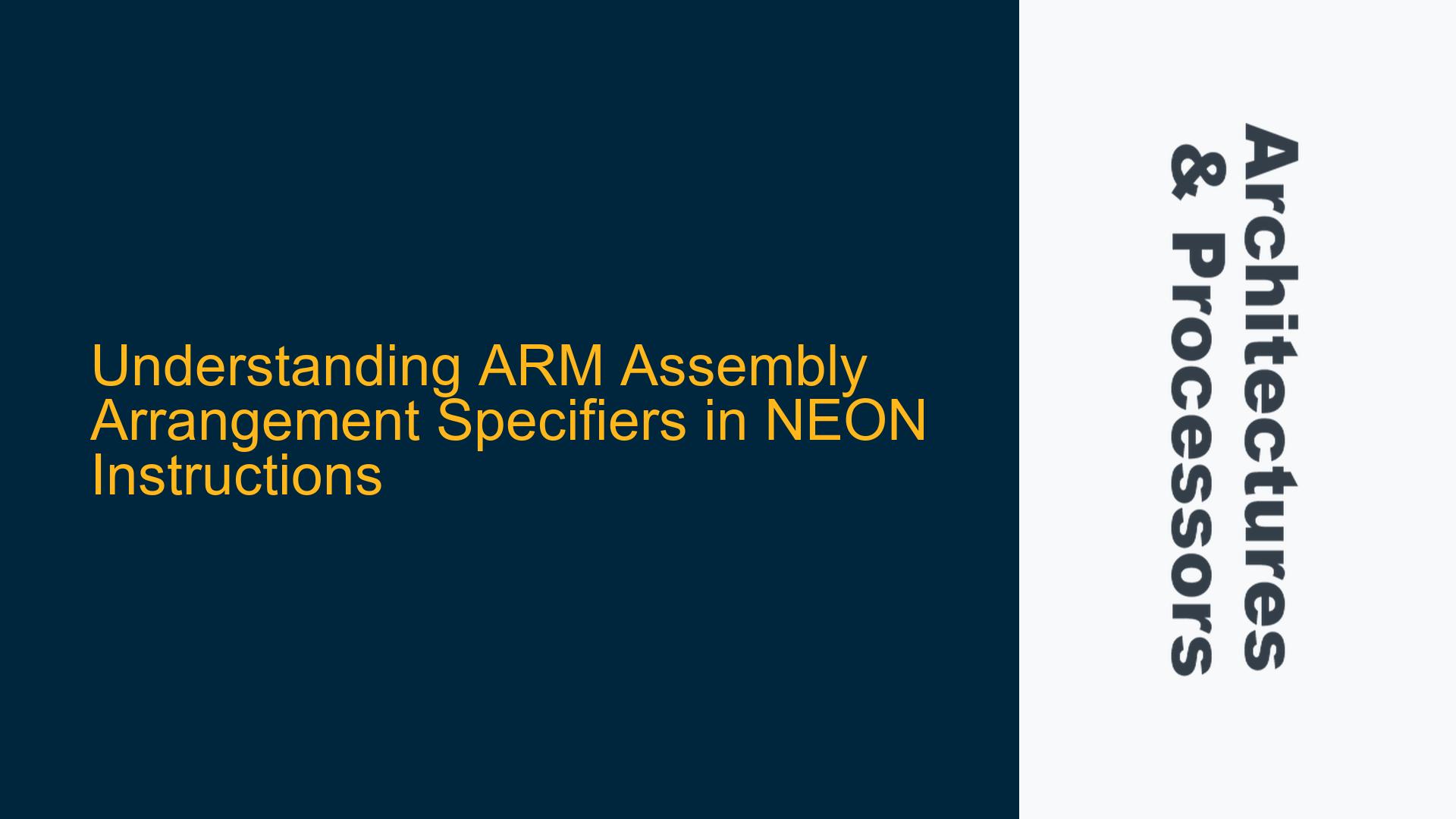ARM NEON Vector Arrangement Specifiers: .16b and .8b Explained
The arrangement specifiers in ARM assembly language, particularly in the context of NEON instructions, are critical for defining how vector registers are interpreted and manipulated. These specifiers, such as .16b and .8b, dictate the granularity and structure of data within the NEON registers, which are 128-bit wide and can hold multiple data elements of varying sizes. Understanding these specifiers is essential for writing efficient and correct NEON code, as they directly influence the behavior of vector operations.
In NEON, a 128-bit register can be divided into multiple lanes, each holding a smaller data element. The arrangement specifier defines the number of lanes and the size of each lane. For example, .16b indicates that the 128-bit register is treated as 16 lanes of 8-bit (byte) elements, while .8b indicates 8 lanes of 16-bit (half-word) elements. This distinction is crucial for operations that manipulate data at the lane level, such as table lookups, arithmetic operations, and data rearrangements.
The arrangement specifier is often denoted as Ta in ARM documentation, where Ta can take values like .16b, .8b, .4h, .2s, etc. Each value specifies a different arrangement of data within the vector register. For instance, in the instruction TBL Vd.Ta, {Vn.16B, Vn+1.16B}, Vm.Ta, the Ta specifier determines how the table lookup operation is performed across the vector registers.
Memory Layout and Data Granularity in NEON Registers
The arrangement specifier not only defines the number of lanes but also influences the memory layout and data granularity within the NEON registers. When a vector register is specified with .16b, it means that the register is divided into 16 lanes, each holding an 8-bit element. This arrangement is particularly useful for operations that require fine-grained manipulation of byte-level data, such as image processing or cryptographic algorithms.
On the other hand, the .8b arrangement divides the 128-bit register into 8 lanes, each holding a 16-bit element. This arrangement is more suitable for operations that involve larger data elements, such as audio processing or certain types of matrix operations. The choice of arrangement specifier depends on the nature of the data and the specific requirements of the operation being performed.
In addition to .16b and .8b, other arrangement specifiers like .4h (4 lanes of 32-bit elements) and .2s (2 lanes of 64-bit elements) are also available. Each specifier provides a different way to interpret the data within the vector register, allowing for a wide range of vector operations to be performed efficiently.
Optimizing NEON Code with Correct Arrangement Specifiers
Using the correct arrangement specifier is crucial for optimizing NEON code. Misusing or misunderstanding these specifiers can lead to inefficient code or even incorrect results. For example, using .16b when .8b is required can result in data being processed at the wrong granularity, leading to unexpected behavior in the application.
To ensure that the correct arrangement specifier is used, it is important to carefully analyze the data being processed and the operations being performed. For instance, if the data consists of 16-bit elements, the .8b specifier should be used to ensure that each element is processed correctly. Similarly, if the data consists of 8-bit elements, the .16b specifier should be used to maximize the number of elements processed in parallel.
In addition to choosing the correct arrangement specifier, it is also important to consider the impact of these specifiers on memory access patterns and cache behavior. For example, using .16b for byte-level operations can lead to more efficient use of the cache, as more data can be loaded into the cache at once. On the other hand, using .8b for 16-bit operations can reduce the number of memory accesses required, as fewer elements need to be loaded into the registers.
Practical Examples of Arrangement Specifiers in NEON Instructions
To illustrate the use of arrangement specifiers in NEON instructions, consider the following examples:
-
Table Lookup Operation: In the instruction
TBL Vd.Ta, {Vn.16B, Vn+1.16B}, Vm.Ta, theTaspecifier determines how the table lookup operation is performed. IfTais set to.16b, the lookup table is treated as 16 lanes of 8-bit elements, and the operation will return the corresponding byte from the table for each lane inVm. IfTais set to.8b, the lookup table is treated as 8 lanes of 16-bit elements, and the operation will return the corresponding half-word from the table for each lane inVm. -
Arithmetic Operations: In the instruction
ADD Vd.Ta, Vn.Ta, Vm.Ta, theTaspecifier determines the granularity of the addition operation. IfTais set to.16b, the addition is performed on 16 lanes of 8-bit elements. IfTais set to.8b, the addition is performed on 8 lanes of 16-bit elements. -
Data Rearrangement: In the instruction
ZIP1 Vd.Ta, Vn.Ta, Vm.Ta, theTaspecifier determines how the data is interleaved. IfTais set to.16b, the interleaving is performed at the byte level, resulting in 16 lanes of interleaved bytes. IfTais set to.8b, the interleaving is performed at the half-word level, resulting in 8 lanes of interleaved half-words.
Common Pitfalls and Misconceptions
One common pitfall when working with arrangement specifiers is assuming that the specifier only affects the size of the data elements. While the specifier does define the size of the elements, it also affects the number of lanes and the overall structure of the data within the vector register. Misunderstanding this can lead to incorrect code that either processes data at the wrong granularity or fails to take advantage of the parallel processing capabilities of the NEON unit.
Another common misconception is that the arrangement specifier can be ignored when working with scalar operations. While scalar operations do not involve multiple lanes, the arrangement specifier still plays a role in determining the size of the data elements being processed. Ignoring the specifier in scalar operations can lead to incorrect results, especially when dealing with mixed data types.
Best Practices for Using Arrangement Specifiers
To avoid these pitfalls and ensure that NEON code is both efficient and correct, it is important to follow best practices when using arrangement specifiers:
-
Understand the Data: Before choosing an arrangement specifier, it is important to understand the nature of the data being processed. This includes the size of the data elements, the number of elements, and the operations that will be performed on the data.
-
Choose the Correct Specifier: Based on the understanding of the data, choose the arrangement specifier that best matches the data and the operations. For example, if the data consists of 8-bit elements, use
.16b. If the data consists of 16-bit elements, use.8b. -
Consider Memory Access Patterns: When choosing an arrangement specifier, consider the impact on memory access patterns and cache behavior. For example, using
.16bfor byte-level operations can lead to more efficient use of the cache, while using.8bfor 16-bit operations can reduce the number of memory accesses required. -
Test and Validate: After implementing NEON code with the chosen arrangement specifier, it is important to test and validate the code to ensure that it produces the correct results. This includes testing with different data sets and verifying that the code behaves as expected under various conditions.
Conclusion
Arrangement specifiers in ARM assembly language, particularly in the context of NEON instructions, play a crucial role in defining how vector registers are interpreted and manipulated. Understanding these specifiers, such as .16b and .8b, is essential for writing efficient and correct NEON code. By carefully analyzing the data, choosing the correct specifier, and considering the impact on memory access patterns, developers can optimize their NEON code and avoid common pitfalls. Following best practices and thoroughly testing the code will ensure that the desired performance and correctness are achieved.






